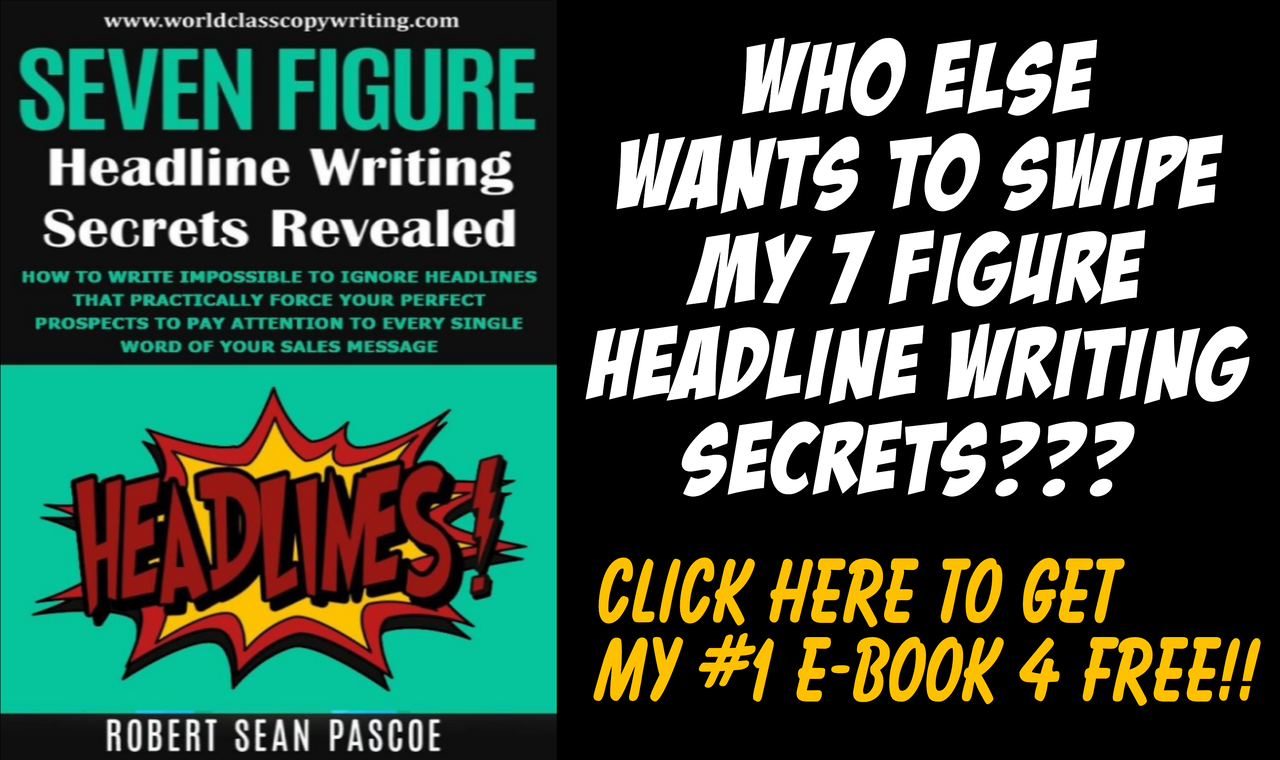
Are Your Landing Pages Falling Flat? Let’s Fix That!
If you’ve ever struggled over how to write landing pages that actually get results, then this MEGA-POST is going to show you everything you need to craft killer copy for your landing pages, or to discern with an expert’s eye what is and what isn’t a quality landing page.
I’m Robert Sean Pascoe, a pro in turning web pages into customer magnets.
For over seven years, I’ve mastered creating landing pages that don’t just attract traffic but convert visitors into buyers. Now, I’m going to reveal many of me secrets to YOU.
Let’s kick things off by looking at different kinds of landing pages, as this can be a bit confusing even if you’ve been in the digital marketing game for awhile like I have…
Lead Generation Pages
Think of lead generation pages as your frontline in the digital battlefield. They’re not just nets for catching fish; they are magnets attracting potential leads. These pages are crafted with a precise balance: offering something valuable enough to entice sharing of contact details. The art lies in creating an irresistible exchange – a lure that promises to solve a problem, answer a question, or fulfill a need. When done right, these pages turn casual browsers into potential leads, ready for nurturing.
Click-Through Pages
Click-through pages are the storytellers of your product or service. They’re where the narrative begins, setting the stage for what’s to come. These pages often use compelling visuals and engaging copy to create a narrative arc that guides visitors to take the next step. Think of them as the opening chapter of a book, enticing the reader to turn the page and discover more.
Squeeze Pages
Squeeze pages are the essence of direct communication in the digital marketing world. They cut through the noise and clutter with a single, focused message. Their purpose is crystal clear: to gather contact details swiftly and efficiently. These pages are often short, sharp, and to the point, creating a sense of urgency that compels action. They’re the digital equivalent of a pitch – quick, direct, and effective.
Sales Pages
Sales pages are your digital salespeople. They work around the clock, pitching your product or service with precision and persuasion. These pages go beyond mere descriptions; they weave a compelling story around your offering, highlighting benefits, overcoming objections, and painting a picture of life after purchase. They are the culmination of your sales process, where all roads in your marketing journey lead.
Thank-You Pages
Thank-you pages are more than mere courtesies; they are opportunities for further engagement. These pages can be platforms for cross-selling, gathering feedback, or building a community. A well-crafted thank-you page not only shows appreciation but also opens doors to deeper interaction, whether through special offers, invitations to exclusive communities, or previews of upcoming products or services.
The Importance of These Different Types of Landing Pages
Each landing page plays a unique role in your digital marketing strategy, like different instruments in an orchestra, each contributing its note to the symphony of your online presence. Understanding and utilizing each type efficiently can transform your digital strategy into a harmonious and effective campaign.
The Psychology Behind High Conversion Landing Pages
Crafting Your Landing Page Content
A. Headlines That Hook
Instant Impact: Your headline is your first, and sometimes only, chance to grab attention. Make it bold and powerful. It should hit the reader like a splash of cold water – awakening and compelling.
Speak Directly to Needs: Craft a headline that zeroes in on what your audience desperately wants or needs. Address a pain point, offer a solution, or invoke curiosity. Think, “How to Triple Your Leads Overnight” or “The Secret to Effortless Weight Loss.”
Keep it Snappy: Long headlines can lose punch. Keep it short, sharp, and to the point. Aim for a maximum of 10 words. Brevity is the soul of wit, and in headlines, it’s the soul of impact.
B. Compelling and Concise Introduction
Set the Stage: The intro sets the tone. It should smoothly transition from the headline, maintaining the momentum. A good intro is like a firm handshake; it should be confident and inviting.
Identify and Empathize: Start by acknowledging the reader’s problem or desire. Show that you understand their situation. This creates an immediate connection.
Promise a Journey: Your intro should hint at the journey ahead. It promises a solution or revelation that’s only a scroll away. It’s a teaser for the treasure that lies beneath.
C. Showcasing Benefits Over Features
What’s in It for Them: Features tell, but benefits sell. A feature is what your product does; a benefit is what the user gains from it. Focus on how your product makes life easier, better, or more enjoyable.
Emotional Appeal: Tap into emotions with benefits. Does your service offer peace of mind, joy, or security? Emphasize these emotional payoffs.
Real-Life Application: Use examples or scenarios that show your product in action. Help the reader visualize the benefits in their daily life. Paint a picture where your product is the hero.
D. Utilizing Bullet Points for Clarity
Easy Digestion: Bullet points break down information into bite-sized, easily digestible pieces. They’re perfect for scanners – people who skim through content.
Highlight Key Points: Use bullets to emphasize crucial benefits, features, or pain points. They’re great for listing stats, steps, or features, making complex information accessible at a glance.
Keep Them Engaged: Each bullet point should provide value and encourage further reading. They should be intriguing enough to keep the reader moving down the page, eager to discover more.
Crafting content for a high-conversion landing page is like painting a masterpiece. Each element, from the striking headline to the engaging intro, the benefits-laden body, and the clear, crisp bullet points, plays a critical role. Together, they create a compelling picture that not only captures attention but also drives action. This content isn’t just words on a page; it’s a carefully orchestrated play designed to lead the reader down a path of discovery, engagement, and ultimately, conversion
Storytelling and Emotional Appeal on Landing Pages
A. Integrating Storytelling in Landing Pages
Craft a Narrative: Your landing page can open with a gripping tale – maybe a client’s life-changing experience or a dramatic before-and-after scenario. Stories create an emotional hook that facts alone cannot achieve, making your product or service more memorable.
Relatable Characters: Develop characters who reflect your audience’s demographics or life situations. When visitors see similar challenges and aspirations in these characters, they feel a stronger connection and believe that your solutions could work for them too.
Problem and Resolution: Use storytelling to demonstrate how your product resolves specific challenges. Illustrate the character’s journey from frustration to relief or success, clearly linking this transformation to your offering. This approach not only informs but also inspires and reassures potential customers.
B. Creating Emotional Connections with Your Audience
Identify Core Emotions: Understand and articulate the emotional drivers of your audience. Is it a drive for success, a longing for security, or a desire for recognition? Your copy should resonate with these underlying emotions, making your audience feel seen and understood.
Empathy is Key: Use empathetic language to create a bond. Show that you not only understand their situation but also share their feelings and aspirations. This empathy turns your landing page into a comforting space where visitors feel valued and understood.
Use Sensory Language: Employ words that stimulate the senses and evoke vivid images or feelings. This type of language can make the experience of using your product or service almost tangible, enhancing the emotional impact of your message.
C. Examples of Effective Emotional Appeals
The Fear of Missing Out (FOMO): Leverage this powerful emotion by creating a sense of urgency and exclusivity. Suggest that delaying action might mean missing out on a life-changing opportunity or a limited offer, prompting immediate action.
The Joy of Achievement: Paint a picture of success and fulfillment that comes with using your product. Help them visualize the positive outcomes and the feelings of accomplishment and pride they can experience.
Trust and Security: For products offering safety or stability, emphasize reliability and trustworthiness. Use scenarios or testimonials that showcase how your product has provided peace of mind or protection, reinforcing the feeling of security it offers.
Incorporating storytelling and emotional appeal into your landing pages is like weaving a spell. It’s not just about presenting a product; it’s about creating an experience, a feeling, a connection.
This approach transforms your landing page from a simple sales pitch into a compelling narrative that resonates deeply with your audience. It makes them feel understood, catered to, and most importantly, motivated to take action. The art of storytelling, combined with the power of emotional appeal, turns your landing page into a captivating journey that leads straight to the heart of your audience.
The Art of the Offer on Your Landing Pages
This section focuses on effectively showcasing your product or service to maximize conversions. This part of your landing page is where strategy meets psychology, and where every detail matters.
By mastering these elements, your landing page becomes more than just a space for presenting an offer; it becomes a compelling, persuasive tool that speaks directly to your audience’s needs and desires, encouraging them to take action.
A. Presenting Your Offer Compellingly
Highlight the Value: Your offer isn’t just a product or service; it’s a key to solving a problem or fulfilling a desire. Emphasize the value and benefits, not just the features. Make the reader feel they’re getting an incredible deal that’s too good to miss.
Make It Irresistible: Use persuasive language that taps into your audience’s core needs and desires. Your offer should sound like the perfect solution they’ve been seeking. Phrases like “transform your business in days” or “unlock unprecedented growth” can create a strong attraction.
Clarity is Key: Be crystal clear about what you’re offering. Confusion kills conversions. Make sure your audience understands exactly what they get, how it benefits them, and why it’s worth their investment.
B. Pricing Strategies and Psychology
Perceived Value: Price your offer to reflect its value. If it’s too low, it might be perceived as low quality. Too high, and you risk alienating your audience. Find the sweet spot where the cost aligns with the perceived value.
Anchoring Effect: Use price anchoring to your advantage. Present a higher-priced option alongside your main offer to make the latter seem more affordable. This contrast can significantly boost the attractiveness of your primary offer.
Payment Options: Offering multiple payment options can widen your appeal. Some customers prefer a one-time payment, while others might find a payment plan more manageable. Flexibility can be a deciding factor for many.
C. Adding Bonuses and Incentives
Relevant Bonuses: Include bonuses that complement the main offer and add real value. For instance, if you’re selling a fitness program, a free nutrition guide as a bonus would be highly relevant and attractive.
Limited-Time Offers: Create a sense of urgency with time-sensitive bonuses. “Sign up in the next 48 hours and receive an exclusive workbook free!” This tactic can nudge those on the fence to take immediate action.
Exclusivity and Scarcity: Use exclusive or limited bonuses to create scarcity. If people believe they’re getting something rare or exclusive, they’re more likely to act quickly to not miss out.
By mastering the art of the offer, you transform your landing page into a powerful magnet for conversions. It’s about presenting your product or service in a way that makes it irresistible, pricing it smartly to reflect its value, and sweetening the deal with well-chosen bonuses and incentives.
This blend of strategies is designed to engage the reader’s interest, tap into their desires, and ultimately, motivate them to take the desired action.





